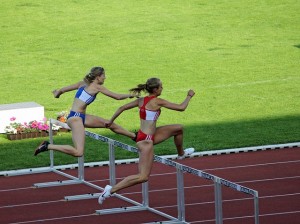Why You Should be Implementing Plyometrics: Part 2
 In part 1 of “Why Implement Plyometrics into Your Training Programs” it was important to note that plyometrics could be a great tool to use in your programming to help athletes achieve success.
In part 1 of “Why Implement Plyometrics into Your Training Programs” it was important to note that plyometrics could be a great tool to use in your programming to help athletes achieve success.
In this blog, there are 3 more reasons that implementing plyometrics can take your programs and athletes’ game to the next level.
3 More Reasons to Implement Plyometrics
Reason #4: Easily Transferable
Plyometric movements mimic sports or game movements. A squat jump can mimic a number of things, a basketball player getting a rebound or a football player jumping to catch a pass.
There are many examples of plyometric exercises that can transfer to the field, court, etc. The greatest thing about that is it creates “buy in” from parents and athletes alike. They can see, feel and apply plyometrics.
Reason #5: Gives You Room to Be Creative
 To keep athletes interested, coaches occasionally need to get creative in their programming. This not only holds interest, but it really is the best thing for the athletes.
To keep athletes interested, coaches occasionally need to get creative in their programming. This not only holds interest, but it really is the best thing for the athletes.
To add energy and excitement use plyometrics.
Pro Example: I may have my athlete perform a regular bench press for a number of reps, and the athlete would immediately move to performing a medicine ball chest press for a certain amount of time (generally 25-30 seconds).
Reason #6: Endurance
Endurance is another little perk of plyometric exercises.
Have athletes do as many burpees as they can in 30 seconds. This finisher will definitely put their endurance to a test.
Pro Tip: Be sure that athletes are proficient in burpees before this challenge. If they cannot complete a great burpee, they need to start their first.
Summary
It is important to note that when developing the complete athlete, plyometrics are very important and can be utilized in many ways. Simple plyometric exercises should be mastered before more complex plyometric exercises are introduced.
Jumping rope, jumping jacks, single leg jumps, skipping, etc. are great ways to introduce plyometrics. Now get out there and have some fun!
About the Author: DeCoreus Leavell
– IYCA High School Strength and Conditioning Specialist Certified
– Assistant Coach at Christian County High School
– In the span of 3 years coached 3 state champions and 15 state placers at the middle and high school level
Check Out 4 Amazing Plyometric Exercises … for FREE!
In Coach Wil Fleming’s short 4-video series, he outlines how plyo exercises improve a variety of movement patterns that increase strength, speed, power and much more.


